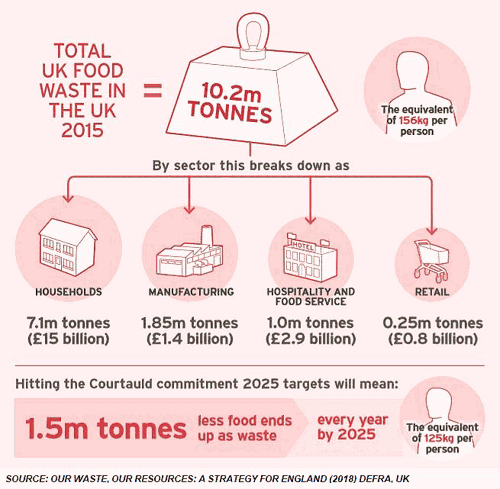Facts about food waste
The latest UK government figures show that around 10 million tonnes of food are wasted every year.

This amounts to a value of £17 billion and a carbon footprint of 20 million tonnes[1], a fifth of the UK’s total greenhouse gas emissions.
Households are the largest contributor to this waste, with 7.1 million tonnes thrown away each year, equivalent to 156kg per person. In homes, ten times more milk is wasted compared to anywhere else in the supply chain[2].
Studies show that 60% of this food waste produced is avoidable[3], meaning that it is thrown away because it is no longer wanted or has been allowed to deteriorate. This includes previously edible items that have gone mouldy such as the 20 million slices of bread binned by UK households every day[4].
Reducing food waste produced, for example by thinking carefully about food purchases and making the most of every product, would allow an average family of four to save up to £70 a month[5], as well as decreasing their impact on the environment.
On a commercial scale, redistribution has an important role to play in ensuring no edible food is wasted and is used for human consumption. WRAP has identified 205,000 tonnes of food that has the potential to be redistributed each year, enough for 250 million meals[6].
The environmental impact of unavoidable food waste can be minimised by recycling via anaerobic digestion where it is used to create renewable energy.
At GENeco in Bristol, the biogas produced from food waste is further processed to obtain biomethane, a renewable gas which is then injected into the national gas grid or used to power vehicles. By recycling the food waste from one household food caddy, enough gas is produced to cook a roast dinner.
When left over food is disposed of alongside unrecycled waste, it is sent to landfill sites. Here, it is broken down by bacteria to produce methane, a greenhouse gas with over 20 times more warming potential than CO2[7].
Avoidance of landfill is not only cheaper, as it cuts out the cost of landfill tax, it also helps to prevent climate change by decreasing the amount of greenhouse gas emissions released into the atmosphere.
[1] Digest of Waste and Resource Statistics 2018 Page 55
[2] Resources Waste Strategy Dec 2018 page 100
[3] Digest of Waste and Resource Statistics 2018 page 55
[4] Resources Waste Strategy Dec 2018 page 109
[5] Love Food Hate Waste (WRAP)
[6] Resources Waste Strategy Dec 2018 page 101
[7] Love Food Hate Waste (WRAP)
